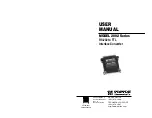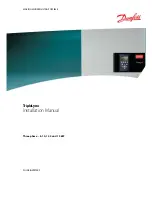
DAC1 PRE
Instruction Manual Rev J
Page 18
Benchmark Technologies
HPA2
™ Headphone Amplifier
The
DAC1 PRE
headphone output is driven
by Benchmark’s signature
HPA2
™ headphone
amplifier. This high-current, high-output
amplifier has an output impedance of near 0-
Ohms. It is designed to drive loads as low as
30 Ohms without any increase in distortion.
It also has sufficient amplitude to drive low-
sensitivity 600-Ohm headphones.
The
HPA2
™ includes current-limiting circuits
that fully protect against damage from short
circuits. This is important because the right
channel of a headphone amplifier will
experience a short whenever a mono phone
plug is inserted into the stereo headphone
jack. Shorts may also occur when a plug is
partially inserted.
0-Ohm Output Impedance
Most headphone amplifiers use series
resistors to maintain stability and protect
against short-circuit conditions. These
resistors are usually at least 30 Ohms, and
have a negative impact on performance. A
headphone amplifier with series resistors may
measure very well when driving resistive
loads. However, the same amplifier will
measure very poorly when driving a
headphone load. Unfortunately, most
manufacturers do not specify headphone
amplifier performance with anything other
than ideal resistive loads. Our measurements
show that headphones do not behave like
resistive loads.
Headphone Performance
In our tests we have measured substantial
distortion across resistors that are wired in
series with headphones. We conducted
measurements with a variety of headphones.
In general, distortion increases as headphone
impedance decreases. This distortion can be
eliminated with a properly designed 0-Ohm
headphone amplifier.
The performance of the
HPA2
™ does not
change when headphones are driven. THD+N
measurements for no-load, 30-Ohm resistive
loads, 30-Ohm headphone loads, and 600-
Ohm headphone loads are virtually identical.
The
HPA2
™ will substantially improve the
sound of 30 and 60-Ohm headphones. It will
make very noticeable improvements with
600-Ohm headphones.
UltraLock
™ Clock System
Accurate 24-bit audio conversion requires a
very low-jitter conversion clock. Jitter can
very easily turn a 24-bit converter into a 16-
bit converter (or worse). There is no point in
buying a 24-bit converter if clock jitter has
not been adequately addressed.
Jitter is present on every digital audio
interface. This type of jitter is known as
‘
interface jitter
’ and it is present even in the
most carefully designed audio systems.
Interface jitter accumulates as digital signals
travel down a cable and from one digital
device to the next. If we measure interface
jitter in a typical system we will find that it is
10 to 10,000 times higher than the maximum
allowable level for accurate 24-bit conversion.
Fortunately, interface jitter has absolutely no
effect on the audio unless it influences the
conversion clock in an analog-to-digital
converter (A/D) or in a digital-to-analog
converter (D/A).
Many converters use a single-stage Phase
Lock Loop (PLL) circuit to derive their
conversion clocks from AES/EBU, Wordclock,
or Superclock reference signals. Single-stage
PLL circuits provide some jitter attenuation
above 5 kHz but none below 5 kHz.
Unfortunately, digital audio signals often have
their strongest jitter components at 2 kHz.
Consequently, these converters can achieve
their rated performance only when driven
from very low jitter sources and through very
short cables. It is highly unlikely that any
converter with a single-stage PLL can achieve
better than 16 bits of performance in a typical
installation. Specified performance may be
severely degraded in most installations.
















































